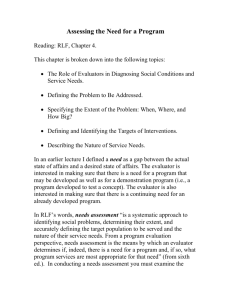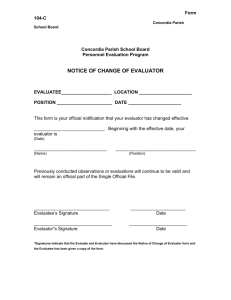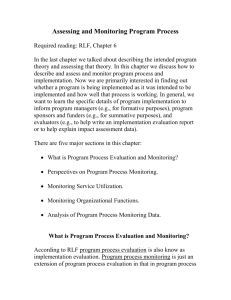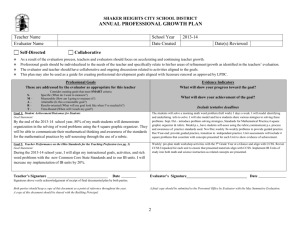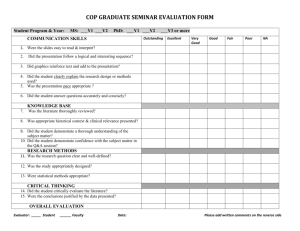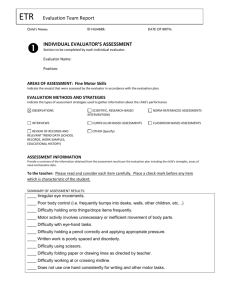Tailoring Evaluations - University of South Alabama
advertisement
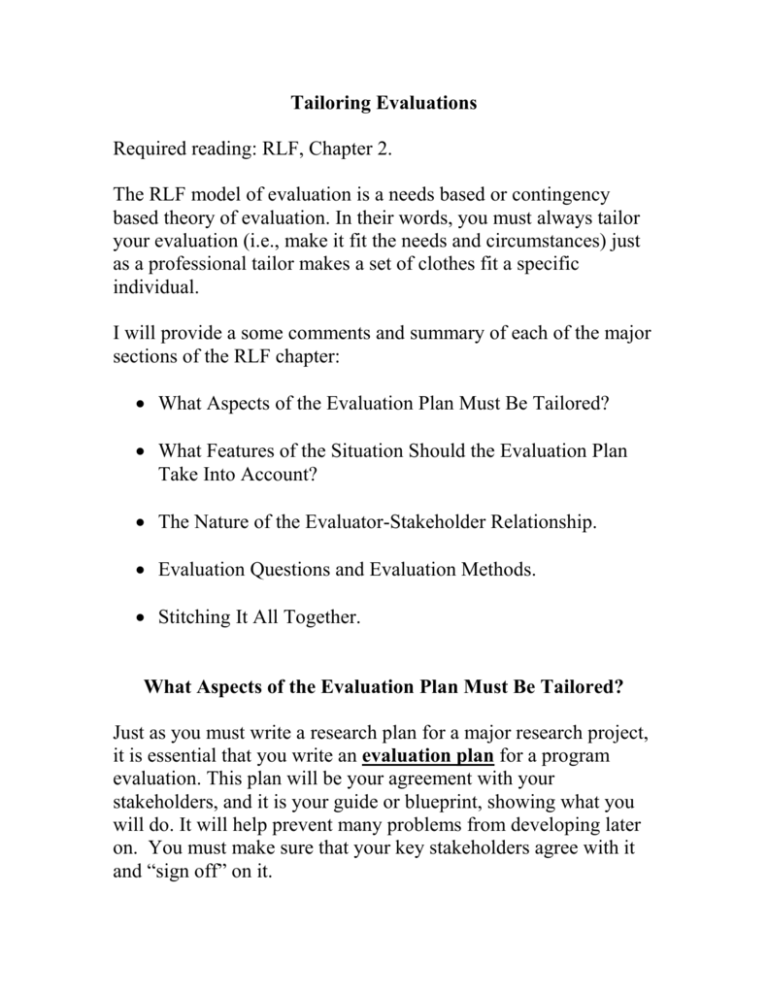
Tailoring Evaluations Required reading: RLF, Chapter 2. The RLF model of evaluation is a needs based or contingency based theory of evaluation. In their words, you must always tailor your evaluation (i.e., make it fit the needs and circumstances) just as a professional tailor makes a set of clothes fit a specific individual. I will provide a some comments and summary of each of the major sections of the RLF chapter: What Aspects of the Evaluation Plan Must Be Tailored? What Features of the Situation Should the Evaluation Plan Take Into Account? The Nature of the Evaluator-Stakeholder Relationship. Evaluation Questions and Evaluation Methods. Stitching It All Together. What Aspects of the Evaluation Plan Must Be Tailored? Just as you must write a research plan for a major research project, it is essential that you write an evaluation plan for a program evaluation. This plan will be your agreement with your stakeholders, and it is your guide or blueprint, showing what you will do. It will help prevent many problems from developing later on. You must make sure that your key stakeholders agree with it and “sign off” on it. RLF list three major areas for tailoring (i.e., questions, methods, and relationships). 1. The questions that need answers are tailored. Basically, it is the questions that forms the heart of a program evaluation in the RLF model. In many ways, everything else emanates from the evaluation questions. Note that this fits nicely with the rule in traditional research methods that the research questions drive the research method, and not the other way around. 2. The methods and procedures to be used are tailored. Once you know your evaluation questions, you can select the best, feasible methods for answering the questions, and you can determine the specific form the methods will take in your evaluation. What is best and what is feasible often conflict in practice; therefore, you will have to determine an appropriate and acceptable balance. 3. The specific nature of the evaluator-stakeholder relationship is tailored for fit. RLF suggest that you specifically include in your evaluation plan when, with whom, and how you will interact with key stakeholders. Two very different styles are highly participatory evaluations and independent evaluations. They also suggest you include a dissemination plan (i.e., when and to whom you will provide feedback, and what form that communication will take) in your evaluation plan. What Features of the Situation Should the Evaluation Plan Take Into Account? The evaluation that you conduct must fit the evaluation needs and context. That is, it must be tailored so that it fits the local needs and context, as well as any broader needs that you have identified. There are three major areas to examine when you begin to tailor your evaluation. First, what it the primary purpose of the evaluation? If the primary purpose is program improvement then you will conduct a formative evaluation. If the primary purpose is program accountability then you will conduct a summative evaluation. If the primary purpose is knowledge generation then you may want to evaluate a demonstration project. Also, knowledge generation, in my view, should be an important secondary purpose of many evaluations. A useful tool for increasing knowledge is to examine the theory behind the program that you are evaluating and try to find out what it is about the program that actually creates the impact. It is also important to publish and share your findings with others so that we can learn from each other and build a knowledge base. (Obviously I’m biased toward knowledge development because I’m primarily an educator. Many evaluators do not hold my bias.) If the primary purpose is hidden agendas then you should reconsider whether you should be doing an evaluation. Unless you can identify some likely positive outcomes of doing the evaluation that far outweigh the negatives, in this case you should recommend that they do not conduct an evaluation until they are ready to do it for the right reasons. Second, what is the nature of the program structure you are considering evaluating, and what are the special situational circumstances needing consideration? RLF discuss three dimensions for consideration (stage of program, political context, and program structure). 1) Obviously the kind of evaluation you will conduct needs to be tailored based upon the stage of the program. For example, are you looking at a new program or an established program? Are they forming a program, restructuring the program, or trying to sum up how well the program is working? What are the stakeholders hoping to work on because of your evaluation results (e.g., goals, implementation, outcomes, efficiency, etc.)? 2) The kind of evaluation you will conduct also needs to be tailored based on the administrative and political context of the program. Are different stakeholder groups in agreement or are they in conflict? If disagreement is present, do you want to use some organizational development strategies (e.g., conflict management, negotiation) to help generate some broader agreement or do you want to work primarily with one or two key individuals and just worry about meeting their needs? It is great when people “buy into” or identify with your evaluation because they are more likely to cooperate and use the results. Whatever approach you plan on using, be clear about what you plan on addressing in the evaluation, what will be done, what will be required from the program being evaluated, and what you will provide during and at the end of the evaluation. 3) The kind of evaluation you will conduct needs to be tailored to the conceptual and organizational structure of the program you are evaluating. Is the program small or large? Is it organizationally complex? Is it implemented at one or many sites? Is it a one-shot program or are clients seen over an extended period of time? Is the program conceptualization (i.e., theory) explicit or is it about as clear as muddy water? In short, what kinds of issues will you need to examine will vary with the specific structure of the program you plan on evaluating. Third, what are the resources available for the evaluation you are planning? Will you have to conduct a small/low budget evaluation or is money not a concern? Will you be able to gain access to the specific resources you need (e.g., program records, data on participants and personnel)? A useful tool is to construct a time chart showing who, does what, when, and include this chart in your evaluation plan. Constructing this makes determining the resources and personnel needed and the ultimate costs easier to determine as you attach costs to each line on the chart. You can also sum these individual costs to obtain the total cost. You must make sure that each person listed under “Who” will commit to carrying out the tasks assigned to them. The Nature of the Evaluator-Stakeholder Relationship RLF list some of the most common stakeholders you might be dealing with when you conduct evaluations: policymakers and decision makers program sponsors evaluation sponsors target participants program managers program staff program competitors contextual stakeholders evaluation and research community RLF briefly discuss the idea of stakeholder participation in evaluations. The idea of participatory or collaborative evaluation has gained popularity over the past 20 years, and this has mirrored or followed similar developments in management theory. One practical question is, however, at what stages of the evaluation should you solicit participation (e.g., in all stages, only during question formation? during data collection)? If you want to use a participatory approach, Exhibits 2-H and 2-I give some helpful advice about what to do. An even more egalitarian style of evaluation is called empowerment evaluation where a primary goal of the evaluation is to develop the capabilities of the stakeholders and program participants to conduct evaluations on their own, to use it for advocacy and change, and to enable these individuals to improve their lives. Some strengths of participatory (and empowerment) evaluation is that it will usually result in a greater sense of ownership of the results, utilization of results will be more likely, and the process is more democratic. On the other hand, it takes a skilled evaluator, trained in organizational development techniques, to facilitate a participatory evaluation, and it can be time consuming. At the opposite end of the participation continuum would be an external, independent evaluator who only works with one or two key people in the organization or program under evaluation. An advantage of having an external evaluator is greater objectivity (i.e., having someone from outside of the program to conduct the evaluation adds credibility, especially for summative evaluations). Note: the term external evaluator refers to someone brought in from outside of the program to conduct the evaluation, and the term internal evaluator refers to someone doing the evaluation who is part of the organization or program under evaluation. One of the key components of empowerment evaluation is that the evaluator teaches the people in the organization or program how to do evaluation so that they can take over these tasks in the future. This idea is based on similar principles found in management theory (i.e., also known in the literature as collateral organization and parallel learning structures). RLF make the important point that no matter what form of participation or collaboration you use in your evaluation, “the resulting project, nonetheless, should represent an application of recognizable evaluation concepts and methods.” You must make sure that you conduct a high quality evaluation, no matter what style it takes. Another important recommendation that you include in your evaluation plan a specific discussion of how you intend to communicate and disseminate the evaluation findings. This section can be called your dissemination plan. In general, interim presentations and informal communication, in addition to the final report, will increase the utilization of the evaluation results. Evaluation Questions and Evaluation Methods In this next to last section of the chapter, RLF give an overview of what they consider the five major evaluation questions and the related data collection or research methods. Remember that the questions drive the methods, and not vice versa. There are separate chapters on each of these five areas later in the textbook. Note that the actual evaluation questions will be more specific (as you will learn in the next chapter) and these questions are determined through interaction between the evaluator and key stakeholders (as well as between the evaluator and any relevant data that are available). Nonetheless, it is useful to examine the five general areas or broad questions as a way of classifying what can be examined in program evaluation. The five general areas of concern in evaluation are as follows: 1) Needs assessment (i.e., questions about the social conditions surrounding a program and the need for program services). 2) Assessment of the program theory (i.e., questions about the conceptualization or design of the program). 3) Assessment of program process (i.e., questions about program operations and service delivery). 4) Impact assessment (i.e., questions about whether the program has an impact and results in the desired outcomes). 5) Efficiency assessment (i.e., questions about program benefits, costs, and efficiency). Remember: It’s about needs, theory, process, impact, and efficiency! (Remember: NTPIE). First, RLF briefly summarize needs assessment from the point of view of the evaluator. The evaluator is interested in whether there is a need for a program that does not yet exist (perhaps recommending that one be developed) or whether there is a need for an already existing program (to make sure that the program is still needed). A need is basically a gap between the actual state of affairs and a desired state of affairs. The evaluator determines the current situation (e.g., many workers in Company XYZ don’t know how to use computers, many adolescents in Mobile, AL are using illicit drugs, etc.) and then the evaluator compares this state of affairs to a standard (90% of workers need to know how to use computers in Company XYZ, all kids caught using drugs in Mobile, AL should be able to get professional help), and, finally, the evaluator draws a conclusion or makes a recommendation for action (e.g., a program should be developed or an existing program appears to be needed). During this process the evaluator must make value judgments about what actually constitutes a problem and about the optimal or desired state of affairs. Some methods that are used in needs assessment are surveys and an examination of social indicators and demographic data. Second, RLF briefly summarize the assessment of program theory from the point of view of the evaluator. It is important that a program’s conceptualization and logic fit the need and fit current “best practices” and social science theory. Assessment of program theory involves determining the program theory (e.g., you may have to make an implicit theory explicit) and then judging that merit of that theory. Some methods used are record and document analysis, interviews, questionnaires, and observation. Third, RLF briefly summarize the assessment of program process from the point of view of the evaluator. If it is a single evaluation it is often called a process evaluation; if it is ongoing it is often called program monitoring. Note that a program might have a fine theory, but if it is not implemented properly one cannot expect results (this is called implementation failure). On the other hand, no matter how well you implement a program, if the theory is deficient, one should not expect positive results or outcomes (this is called theory failure). Another issue is whether the program is being implemented ethically and as required (for government programs) by legal statutes. It is often useful to set up a performance monitoring system as part of a management information system to provide regular feedback to program personnel and stakeholders. The evaluative question is, Does the actual program implementation match the implementation standards. Some common data collection methods are examining program records and conducting surveys. Fourth, RLF briefly summarize impact assessment from the point of view of the evaluator. In other words, Does the program have an impact? and What is its impact? The evaluator tries to compare what actually occurs in the presence of the program with the counterfactual. The counterfactual is what would have occurred in the absence of the program. (The difference between what arose and what would have arisen if the program had not been implemented is the impact of the program.) The evaluator usually gets an estimate of program impact using experimental or quasiexperimental designs, although other, generally weaker approaches, are also used. For example, in a simple one-group pretest-posttest design you would compare the posttest measure with the pretest measure (here the counterfactual is the pretest or baseline measure). If you had a control group, then you would get the estimate of the counterfactual from the control group (i.e., you use the control group to tell you what would have happened without the program). Impact assessment data are essential if an evaluator is to make a judgment about the merit and worth of the program! Obviously if the program has no impact, it is not a good program. Fifth, RLF briefly summarize efficiency assessment from the point of view of the evaluator. It is important to remember that documentation of program impact is not enough! You also need to think about efficiency because the program’s impact may be very small in relation to the amount of resources required to obtain the impact. There are several efficiency questions that may be of interest: (Note that I’m giving you some material that RLF will give you in the later chapter on efficiency. If you get it now, it will be easier later.) (a) What is the cost effectiveness of the program or, said another way, how much “bang for the buck” does the program give you (i.e., how much outcome do you get, on average, for each dollar spent)? (b) How does the “bang for the buck” of the program you are evaluating compare to other similar programs that could be implemented instead (just compare the cost effectiveness ratios of the programs)? According to question (b) you are looking for the cheapest way of doing something. That is, what program gives you the most outcome (e.g., the most learning, the most reduction in drug use, etc.) per dollar spent? (c) How do the benefits (in dollar units) of the program compare to the costs (in dollar units) of the program? The ratio of benefits to costs (i.e., the benefits in dollar amount divided by the costs in dollar amount) is called the benefit-cost ratio. If the benefit-cost ratio is less than one then the program should not be continued (because the costs are greater than the benefits). (d) How does the benefit-cost ratio of the program you are evaluating compare to the benefit/cost ratios of other similar programs that could be implemented instead? In other words, which program gives you the most benefits in relation to costs? Note that (a) and (b) are cost-effectiveness analysis questions and (c) and (d) are benefit-cost analysis or cost-benefit analysis questions. It is a matter of preference whether one uses the term benefit-cost assessment or cost-benefit assessment. Economists use both terms. Cost-effectiveness and benefit-cost analysis are what economists do when they do program evaluation (i.e., it, pretty much, is their definition of program evaluation). Efficiency assessment reflects the economist’s way of thinking about program merit and worth. The main point of this chapter was to show how a program evaluation can be tailored to the specific program circumstances and needs that you may face when you conduct an evaluation.
